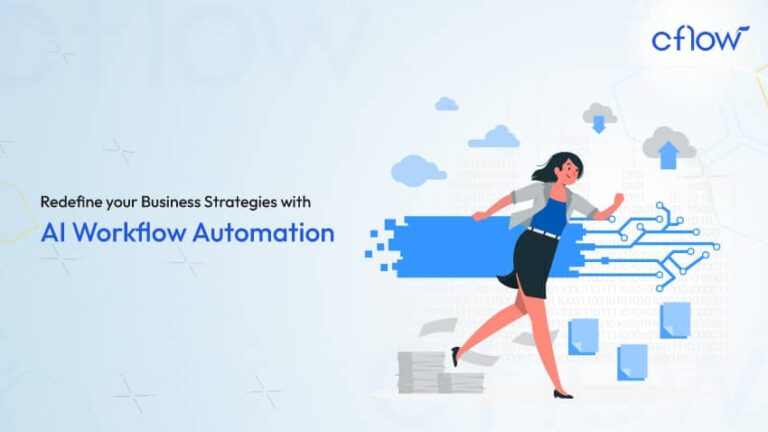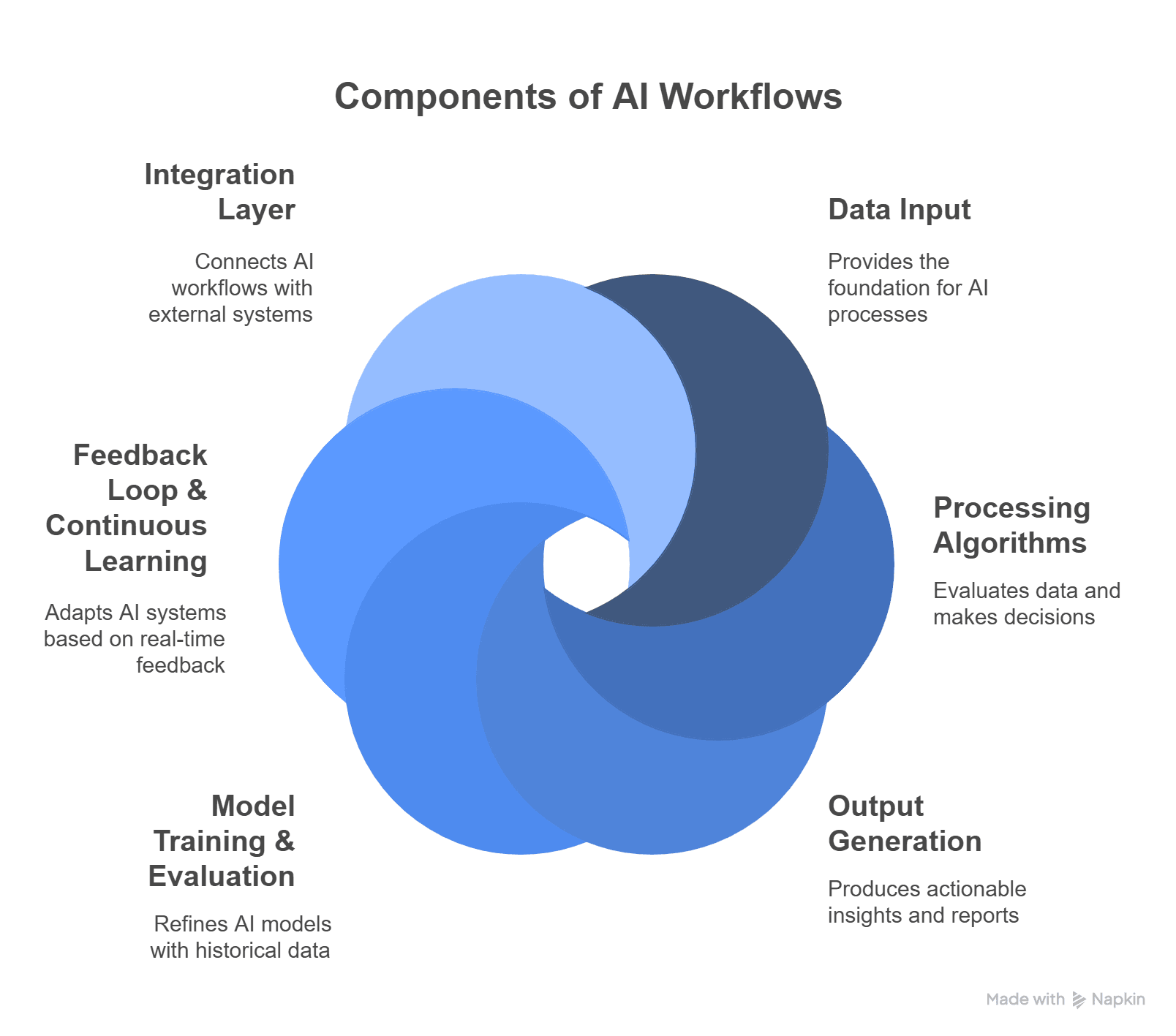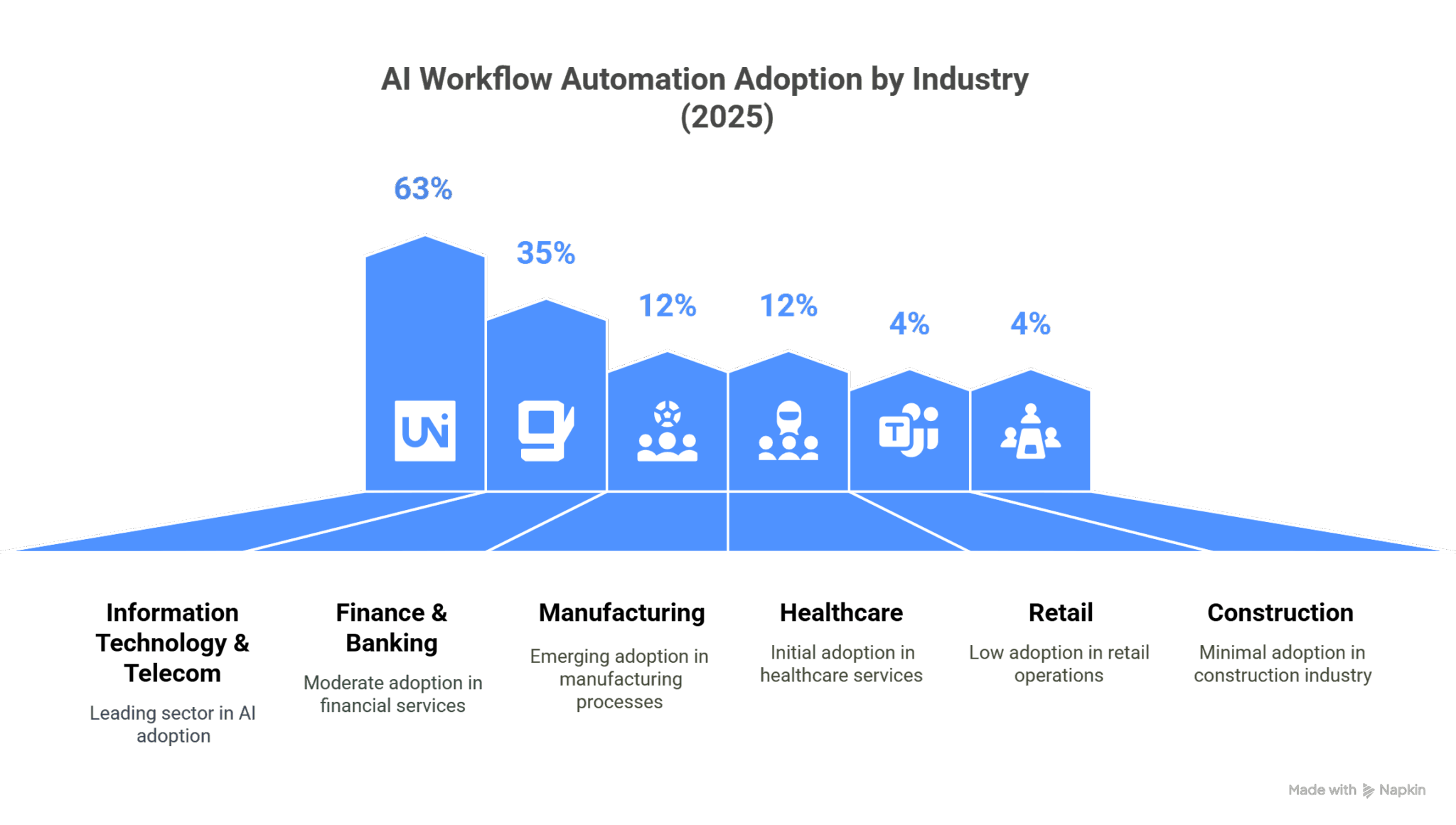Redefine your Business Strategies with AI Workflow Automation

Key takeaways
- In 2024, 41.17% of EU enterprises used AI, yet many have not fully explored AI workflow automation benefits.
- AI workflow automation streamlines tasks, minimises errors, and improves process efficiency with intelligent decision-making capabilities.
- Sales and marketing teams can scale productivity through automated lead generation, follow-ups, and personalised customer engagement.
- Tools like Cflow enable businesses to build no-code AI workflows, integrate systems, and automate processes from start to finish.
AI workflow automation is a prevailing business trend. According to Eurostat, in 2024, 41.17% of large enterprises in the European Union employed AI technologies, marking a significant increase from previous years. Despite this growth, many businesses have yet to fully explore the realm of automation and its potential benefits. If you’re aiming to enhance agility, performance efficiency, and scalability in your processes, AI workflow automation could be the solution.
Read further to understand more about AI workflow automation and its benefits for business organisations.
What is AI Workflow Automation?
By leveraging Artificial Intelligence, workflows are optimised to minimise task inefficiencies and errors. An AI workflow will effectively streamline the tasks by properly lining them up and only using limited resources.
Implementing an AI workflow allows businesses to negate limitations and improve the efficiency of these processes by freeing employees’ valuable time. This also allows them to focus on tasks that need their input. This finally increases productivity and efficiency of the overall performance.
AI workflow automation is the process that uses AI to optimise all business processes. The most common repetitive and redundant tasks like data entry, data processing, and analysis are automated using workflow AI where computers and software take over such mundane tasks. The AI workflow solution also makes it possible for users to integrate external applications and tools.
An Overview of AI Workflow Automation
The automation strategy of the workflow is designed in such a way that it integrates different algorithms and machine learning into regular manual workflows. AI, with its learning abilities, can mimic any cognitive actions performed by humans, adapt to them, and eventually perform better. Hence, the workflows of the processes are working with intelligent automation and cognitive abilities.
In comparison to this, the traditional automation system can easily perform predefined processes. This is where AI-based automation marks its difference. In an AI automation workflow, the software or the system has the potential to think, learn, and make necessary decisions autonomously for the process to move forward, done under the supervision of a human.
The Collaboration of BPM and AI workflow automation
Conventional BPM methods along with AI workflow automation make the best tool set for improving your business processes. BPM decides on the end-to-end process framework whereas, AI’s purpose is to automate certain tasks in those processes.
This integration improves the tasks by enhancing the process flow and also improving its design, performance, and monitoring capacities. Additionally, these are accompanied by intelligent decision-making and workflow optimisation.
AI adoption in BPA is projected to grow from 74% in 2024 to 94% by 2029, indicating a significant shift towards intelligent automation.
Key Components of AI Workflows
Understanding the key components of an AI workflow is essential to implementing a scalable and effective automation system. Here’s a comprehensive look at each component:
1. Data Input
Data input serves as the foundation of any AI workflow. It fuels the automation by providing relevant, structured, and high-quality information from multiple sources—such as spreadsheets, CRMs, or IoT sensors.
Imagine dealing with two datasets: one clean, well-structured, and relevant; the other, disorganised and error-prone. The former will always yield better automation outcomes. That’s because AI models and logic engines rely on data accuracy to function optimally.
Data orchestration ensures that inputs are collected, validated, and routed correctly across the workflow. This includes workflow orchestration (task flows) and dataflow automation (movement of information). Without organised data, even the most advanced algorithms can fail.
Why this matters: AI output quality is directly tied to input quality. Poor data leads to flawed decisions and operational risks.
2. Processing Algorithms
At the heart of an AI workflow lies its processing engine—algorithms that evaluate data, make decisions, and move processes forward.
Initially, these may be rule-based algorithms that follow predefined business logic. For example, “If invoice amount > $10,000, route to CFO.” However, AI workflows increasingly incorporate machine learning (ML), which enables the system to learn from past data and improve over time.
In addition, Robotic Process Automation (RPA) often works alongside these algorithms to handle repetitive, structured tasks—such as copying data between systems or triggering notifications. Once configured, these components eliminate the need for manual intervention in day-to-day operations.
3. Output Generation
Output generation is the final execution stage of an AI workflow. This is where decisions are made, actions are triggered, or insights are produced.
Outputs may include:
Automated reports and dashboards
Predictive analytics and recommendations
Image or text generation
Triggered events like email alerts or approvals
This stage enhances productivity by automating deliverables that would otherwise require manual analysis and execution, significantly reducing turnaround times.
4. Model Training & Evaluation
In workflows involving predictive analytics or natural language processing, AI models must be trained using historical data. This involves:
Selecting features (data attributes)
Feeding labeled data for supervised learning
Evaluating model accuracy using test datasets
Once deployed, models continue to be refined with new data. This ensures the AI system evolves to meet dynamic business conditions.
Example: A loan approval workflow may train a model to identify high-risk applications based on past outcomes.
5. Feedback Loop & Continuous Learning
Modern AI workflows benefit from real-time feedback loops that allow the system to learn and adapt.
For instance, if an AI system recommends actions that users frequently override, it can adjust its decision logic. This feedback improves performance, reduces false positives, and ensures decisions stay aligned with business goals.
Some systems use reinforcement learning to make intelligent adjustments over time without needing manual rule updates.
6. Integration Layer (APIs & Connectors)
No AI workflow operates in a vacuum. Integration with external systems—ERP, CRM, HRMS, databases, and cloud platforms—is crucial for:
Seamless data access
Triggering actions in third-party tools
Maintaining data consistency across the organisation
This is achieved through APIs, webhooks, and no-code connectors. A strong integration framework ensures the workflow ecosystem remains connected and responsive.
Example: A customer service AI workflow can fetch ticket data from Zendesk, process sentiment using NLP, and log the resolution in Salesforce.
Why is AI Workflow Automation Important?
Ultimately, every business aims to achieve growth achieving productivity, profit, and sustainability. Therefore, automating processes becomes a necessary solution. Automation optimises the tasks in a workflow that makes processes more profitable and successful. Even the slightest upgradation of tasks can bring exponential beneficial changes to the business. Let us look at some of the benefits garnered from AI workflow automation.
Benefits of Workflow Automation with AI
Improved Efficiency and Productivity
Automating is the best solution when it comes to improving the efficiency and productivity of your business. Automating processes is much easier and resource-efficient than manually trying to reduce limitations. For example, suppose a business is automating its customer service workflow using an AI workflow builder. In that case, it will be able to respond and address queries much faster and get high levels of customer satisfaction.
Better Data Analysis
Traditionally, businesses were driven by experience and knowledge about the processes. However, today they are driven by data. This leads to a piling up of data to deal with. Dealing with data is a tedious task and that is why automation is important. AI automation workflow tools have the potential to deal with heavy data and analyse it better and faster than humans. Moreover, these tools can also give feedback for better outcomes next time.
Cost Savings
AI workflow automation platforms cost comparatively less than the team manually managing all the tasks. The left-out cost can be invested in a more valuable process like hiring new employees. Additionally, an AI workflow will minimise the errors, saving more budget.
Faster Time-to-market
Faster time-to-market can bring more revenue to your business. It also gives a strong market share and escalates your business agility. Being more agile means your business will be able to adapt to changes quickly. This is best suited for businesses that handle a large amount of manual work and can witness visible changes in the output.
Reduces Human Error
Human errors are inevitable in a manual setup. Manually performing business processes can be monotonous and it can get the best out of the workforce. It is a fact that automation is more reliable than humans. No wastage of budget or resources occurs making the process affordable and an errorless process can be obtained.
It Scales Teams of all Sizes
AI workflow automation is the best solution for businesses with numerous complex processes and large workforce. It can be an effective tool for managing the business and administrative processes together.
How to Implement AI Workflow Automation
1. Assess your Current Workflows
Research and analysis of the existing setup is the first step that a business must take to implement AI in workflow automation. With such an analysis, you will be able to identify the areas of improvement. The current processes have to be scanned in depth to understand where the processes have to be enhanced and also determine the processes or tasks within a process that has to be automated.
2. Map out the Process
Once you identify the processes that have to be automated, you will be able to identify the workflows that have to be automated. In this stage, you will have to check the tasks’ efficiency by measuring the results obtained with the expected results.
3. Choose the Right AI Automation Tool
When all the workflows are identified, your next step is to determine the right tool for your workflow automation. Choosing the right tool is highly important for acquiring the right results. It should also be noted that it also helps you meet your organisational goals. Additionally, the tool must have the features that you desire and require. Extra features may lead to extra payment. Cflow is an ideal AI workflow automation tool in which businesses can completely invest.
4. Automate the Process
This is the stage where the inefficient processes are automated. All the complex processes that fail to give the right outcome will be transformed into efficient ones. Here, the automation steps taken will be completely based on the analysis done while mapping. Therefore, only a defined number of employees and resources will be required.
5. Test and Refine
Once the rule-based automation algorithms have been set into the workflow, it is now time to test run the AI workflow and generate results. These have to be tested for different error cases to ensure that it does not take an unexpected turn.
6. Monitor and Optimise
Once the test run has been done, the necessary changes have to be made to the processes. It is also ideal to collect process feedback to negate any possible drawbacks. Once the implementation is completely done, the automated processes have to be monitored continuously to detect any flaws. To monitor them, certain key performance indicators (KPIs) can be used. Some of these parameters can be as follows-
- Customer satisfaction
- Cost savings
- Time savings
- Process efficiency
End-to-end workflow automation
Build fully-customizable, no code process workflows in a jiffy.
Who Benefits from AI Workflow Automation?
There is no exception in departments that would benefit from AI in workflow automation. However, the departments that would gartner the highest impact of an AI-based workflow are-
- Sales
- Marketing
Once these two teams in an organisation completely automate their routine work, there is going to be a considerable improvement in the efficiency of the entire business.
1. Sales
Sales is about more than just following up with the leads. Today, even an entry-level sales stage must be incorporated with CRM workflow solutions to keep everything organized. However, just with a CRM system, every tedious task is not taken care of. Some of these include –
- Business Development Representative (BDR) – BDR is steps taken in the pipeline of sales through outbound campaigns and outreach.
- Sales Development Representative (SDR) – SDR is for finding and qualifying leads before they are brought into the further roadmap.
- Account Executive (AE) – AE is for closing the deals through communication. This can be through different means like product demos, one-on-one calls, etc.
Keeping up with these tasks can be highly laborious. Research by Gartner shows that 84.3% of SDRs fail to meet their monthly quota. The study also shows that 33.3% of established companies have SDR time management as one of the top three problems.
Automated AI Workflows for Business Development Representatives (BDRs)
The role of BDR is to generate new leads and turn them into potential customers. This can be achieved in several ways. Once the lead engages with the intimation, they are gradually sent to CRM where the SDR will take over.
It has to be noted that the process where the sales representative has to reach out manually and contact is time-consuming. Moreover, it is repetitive and they spend time modifying the outreach templates and also tracking the responses from the prospective customers.
The solution to this time-consuming process is an automated AI workflow that will automatically optimise the repetitive process.
Automated AI Workflows for Sales Development Representatives (SDRs)
The SDRs take over from where the BDRs left off. When a lead engages with the communication initiated by you, they are deemed as “warm”. Here, the SDR will take it up the sales pipeline.
This is only possible with multiple follow-ups using numerous methods like email, social media, etc. SDR work must be done with precision as there is a high possibility of losing the interested prospect. This will require SDRs to have good organisational skills.
A workflow automation AI will aid SDRs in sending warm prospects customised messages and encourage follow-ups at the right time.
Automated Workflows for Account Executives (AEs)
AEs can acquire the same benefit with AI workflow automation. Repetitive tasks such as email generation, appointment scheduling, and further dealings. Leveraging an AI workflow can help AEs save time and simultaneously focus on tasks with high value like focusing on building symbiotic rapport with the prospects and closing deals.
Automated AI workflows can handle and organise all the acquired leads and lead them through the sales funnel without missing one.
2. Marketing
Marketing is a summing up of several areas that make your product or service to your target audience. Some of these include –
- Search engine optimisation
- Email marketing
- Social media marketing
- Affiliate marketing
- Word-of-mouth marketing
All these are specific ways in which the marketing team can drive traffic to the business and convert the traffic into paying clients. To make this happen, a strategic approach has to be taken. Traditionally, to rank high on Google ranking, a marketer has to follow a time-consuming and repetitive process –
- Find the right keyword
- Determine the secondary keywords to be included
- Come up with a framework for the content
- Write engaging and informative content
- Edit, proofread, optimise, and publish the content
- Monitor, track, and optimise for better growth
Investing in AI-based workflow automation will enable them to bring in organic traffic. AI and machine learning have brought in several solutions that make finding the keywords much easier. By using these solutions, all the tasks in the marketing processes can be automated making it streamlined and time-bound.
Types of AI Workflow Automation
1. Predictive Analytics Automation
If you are looking forward to improving and boosting profitability, improving operations, predicting sales forecasts, and also widening your customer base, predictive analytics automation would be the best choice of workflow automation method.
Predictive Analytics Today (PAT) research reveals that 52% of businesses use predictive analytics automation for the above-mentioned achievements. Predictive analytics works by combining artificial intelligence (AI) as well as machine learning (ML).
2. Cognitive Automation
With the combination of artificial intelligence and process automation, cognitive automation helps businesses to boost desired outcomes. The method of cognitive automation involves different approaches like capturing data, automated decision-making, etc. Unlike so many other AI solutions, cognitive automation tools have the potential to imitate the way humans think.
3. Rules-based Automation
A rules-based automation model works on rules set by humans. These rules are used to store, sort, and manipulate data. This way, it can mimic human intelligence. All sorts of repetitive tasks can be automated using rules-based automation offering new levels of efficiency in labour.
Steps in Choosing the Right AI Workflow Tool
- Determine your needs with AI workflow
- Check all the essential features and their compatibility with your business
- Look for integrating properties with external applications
- Check if the platform has easy navigation
- Check if it fits your budget
Challenges with AI Workflow Automation
Isolately investing in solutions like RPA, AI, etc, still fails to offer complete end-to-end process automation. Due to this, the efficiency pathway is left halfway. Therefore, there is a necessity to have a broader spectrum of tools all in one place instead of disconnected ones. Having to deal with multiple tools is difficult. Some of the challenges include –
- Have to face higher maintenance costs
- Increased need for skilled labour and tools
- A need for complex integration arises to connect the different automation tools
- Advancements in technology further complicate the tool combination
- Tools may overlap and can loosen control over the process.
On the whole, all these challenges lead to cost-inefficiency that completely overshadows the purpose of implementing automation in the first place. Hence, to overcome these challenges, it is necessary to find the right tool.
Cflow’s Powerful AI Workflow Automation
As we have seen the benefits that AI workflow automation tools offer, it is essential to choose the right tool. Cflow offers a perfect customizable suite for beginning your automation journey. The platform is no-code workflow automation software, where processes can be automated with simple steps.
- Cflow offers flowchart-based workflows where users can just drag and drop icons to assemble the stage.
- Cflow offers pre-designed and customizable templates for any business processes the users want.
- Cflow’s rules engine is where the users can embed the rules that help the processes navigate by making certain decisions.
- Cflow allows easy assigning and routing of tasks to multiple users. Customised reminder notifications can be sent to users.
- Cflow enables integration with several other SMB applications like Slack and QuickBooks.
- Cflow provides its users with customised graphical reports and analytics that help in assessing the processes’ performance.
Conclusion
With AI workflow automation solutions, you can cut costs, remove repetitive and monotonous tasks, and more importantly enhance the efficiency of the processes. Cflow’s AI workflow automation can streamline and optimise every task to deliver maximum productivity. This is one effective way to empower your workforce.
Sign up today on Cflow and leverage the benefits.
FAQs
1. What is AI workflow automation and how does it work?
AI workflow automation uses artificial intelligence to automate repetitive tasks, improve accuracy, and drive decisions—minimising manual intervention across business operations.
2. Which departments benefit most from AI workflow automation?
Sales, marketing, and IT benefit significantly. IT teams use AI workflows for ticket triaging, system alerts, and process escalations, boosting service delivery and uptime.
3. What are the key components of an AI workflow?
They include structured data inputs, intelligent algorithms, decision rules, actionable outputs, continuous learning, and integration with enterprise systems.
4. Why should businesses invest in AI workflow automation?
It reduces operational delays, enhances customer and employee experience, and ensures scalability—while lowering costs and improving compliance.
5. How do you implement AI workflow automation in your company?
Start by auditing manual processes, defining automation goals, and selecting an AI-ready no-code platform like Cflow to streamline and deploy workflows.
What would you like to do next?
Automate your workflows with our Cflow experts.



